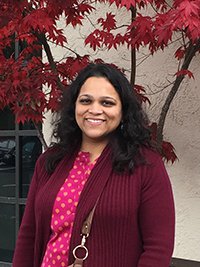Latha Baskaran

Address:
4800 Oak Grove Drive
M/S 233-300
Phone:
818-393-2992Curriculum Vitae:
Click hereMember of:
Carbon Cycle And EcosystemsBiography
Dr. Latha Baskaran is a Geospatial scientist with experience in spatial modeling, Arctic ecosystems, energy systems and environmental indicators. She has worked on Geographical Information Systems (GIS) and remote sensing applications in areas of carbon cycle, biodiversity, ecology and hydrology. She is also interested in multiscale analysis using information collected across sensors - satellite-borne, airborne and ground-based.
Education
- Ph.D., Geography, The University of Tennessee, Knoxville, TN (2017)
- M.S., Geography, Pennsylvania State University, State College, PA (2003)
- B.E., GeoInformatics, Anna University, India (2001)
Professional Experience
Jet Propulsion Laboratory, Pasadena, CA
- Geospatial technologist, Carbon Cycle & Ecosystems Group (2019 - present)
Oak Ridge National Laboratory, Oak Ridge, TN
- Research scientist, Environmental Science Division (2005 - 2018)
- Post-masters research associate, Environmental Science Division (2003 - 2005)
Research Interests
- Methane hotspots in Arctic-Boreal Ecosystems
- Land cover and land use change and disturbances associated with the oil and gas industry in the Arctic
- Analyzing spatiotemporal trends of the carbon-climate cycle
- Geospatial data and visualization support for satellite missions and projects
- Use of imaging spectroscopy, lidar and radar for vegetation mapping
- Environmental indicators associated with energy systems
- Hydrologic modeling
Selected Publications
- Baskaran, L.M., Elder, C.M., Bloom, A.A., Shuang, M., Thompson, D.R., and Miller, C.E. 2022. Geomorphological Patterns of Remotely Sensed Methane Hot Spots in the Mackenzie Delta, Canada. Environmental Research Letters, 17(1). https://doi.org/10.1088/1748-9326/ac41fb.
- Yang, D., Morrison, B.D., Hanston, W., McMahon, A., Baskaran, L., Hayes, D.J., Miller, C.E. and Serbin, S.P. 2023. Integrating very-high-resolution UAS data and airborne imaging spectroscopy to map the fractional composition of Arctic plant functional types in Western Alaska. Remote Sensing of Environment, 286, p.113430.
- Dozier, J., Bair, E.H., Baskaran, L., Brodrick, P.G., Carmon, N., Kokaly, R.F., Miller, C.E., Miner, K.R., Painter, T.H. and Thompson, D.R. 2022. Error and Uncertainty Degrade Topographic Corrections of Remotely Sensed Data. Journal of Geophysical Research: Biogeosciences, 127(11). https://doi.org/10.1029/2022JG007147.
- Norton, A.J., P.J. Rayner, Y.P. Wang, N.C. Parazoo, L. Baskaran, L., P.R. Briggs, V. Haverd, and R. Doughty. 2022. Hydrologic connectivity drives extremes and high variability in vegetation productivity across Australian arid and semi-arid ecosystems. Remote Sensing of Environment, 272, 112937.
- Liu, J., L. Baskaran, K. Bowman, D. Schimel, A.A. Bloom, N. Parazoo, T. Oda, D. Carroll, D. Menemenlis, J. Joiner, and R. Commane. 2021. Carbon monitoring system flux net biosphere exchange 2020 (CMS-Flux NBE 2020). Earth System Science Data, 13(2), pp.299-330, https://doi.org/10.5194/essd-13-299-2021.
- Parish, E.S., L. Baskaran, and V. H. Dale. 2021. Framework for assessing land management effects on species of concern: An example using wood pellet production and the gopher tortoise. WIREs Energy and Environment, 10(1), p.e385. https://doi.org/10.1002/wene.385.
- Gorelick, D. E., L. M. Baskaran, and H.I. Jager. 2019. Visualizing feedstock siting in biomass production: Tradeoffs between economic and water quality objectives. Land Use Policy, 88, 104201.
- McBride, A.C., V.H. Dale, L.M. Baskaran, M.E. Downing, L.M. Eaton, R.A. Efroymson, C.T. Garten Jr., K.L. Kline, H.I. Jager, P.J. Mulholland, E.S. Parish, P.E. Schweizer, and J.M. Storey. 2011. Indicators to support environmental sustainability of bioenergy systems. Ecological Indicators. 11: 1277-1289.
- Baskaran, L., H.I. Jager, P.E. Schweizer, and R. Srinivasan. 2010. Progress toward evaluating the sustainability of switchgrass as a bioenergy crop using the SWAT model. Transactions of the American Society of Agricultural and Biological Engineers 53(5): 1547-1556.
- Jager, H.I., L. M. Baskaran, C. C. Brandt, E. B. Davis, C. A. Gunderson, S. D. Wullschleger. 2010. Empirical geographic modeling of switchgrass yields in the United States. Global Change Biology: Bioenergy 2: 248-257.
- West, T.O., C.C. Brandt, L.M. Baskaran, C.M. Hellwinckel, R. Mueller, C.J. Bernacchi, V.P. Bandaru, B. Yang, B.S. Wilson, G. Marland, R.G. Nelson, D.G. De La Torre Ugarte, and W.M. Post. 2010. Cropland carbon fluxes in the United States: increasing geospatial resolution of inventory-based carbon accounting. Ecological Applications. 20:1074-1086.
- Baskaran, L., V. Dale, W. Birkhead, and R. Efroymson. 2006. Habitat modeling within a regional context: An example using Gopher Tortoise. American Midland Naturalist. 155: 335-351.
- Dale, V., M. Aldridge, T. Arthur, L. Baskaran, M. Berry, M. Chang, R. Efroymson, C. Garten, C. Stewart, and R. Washington-Allen. 2006. Bioregional Planning in Central Georgia. Futures. 38:471-489.